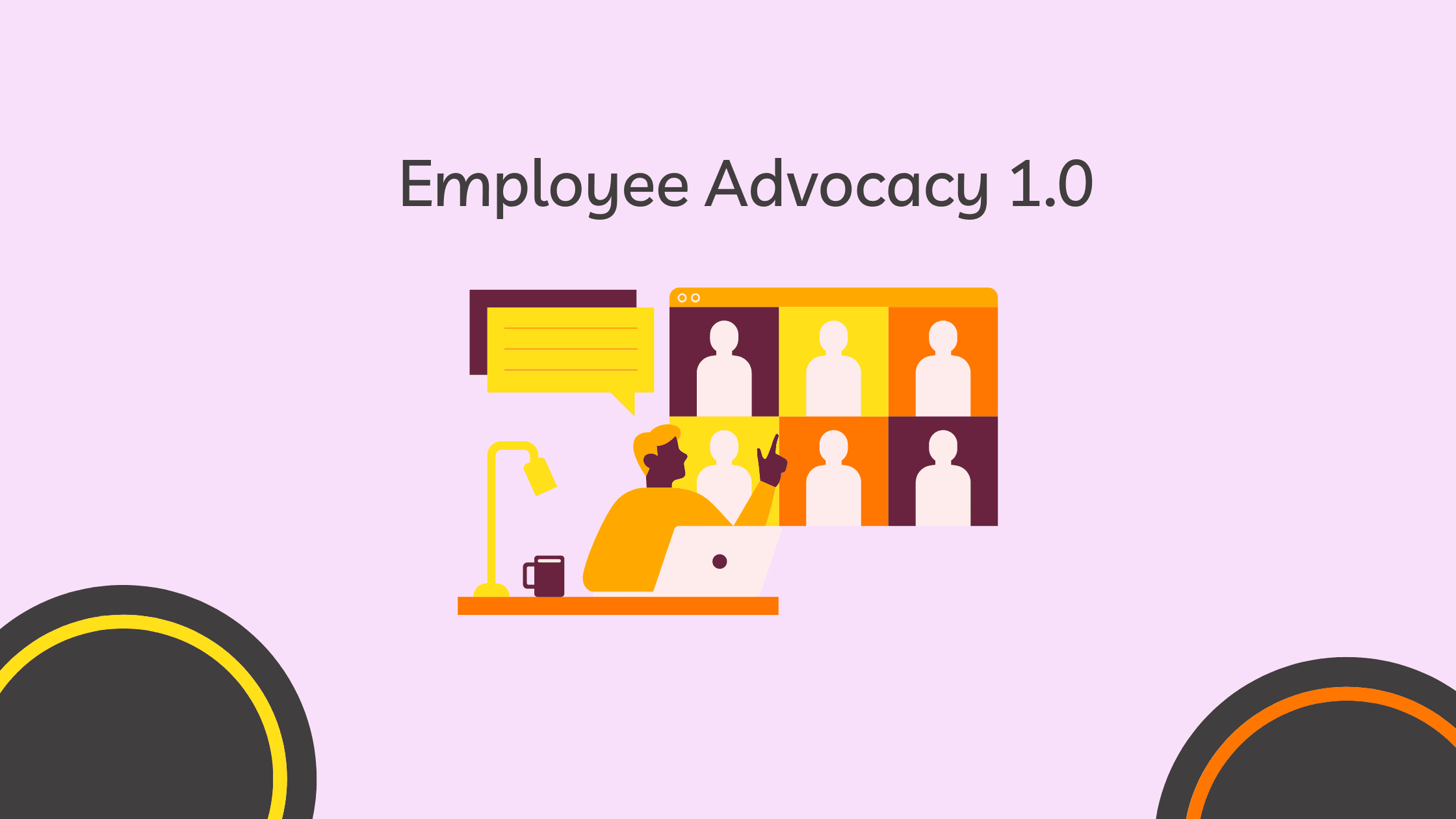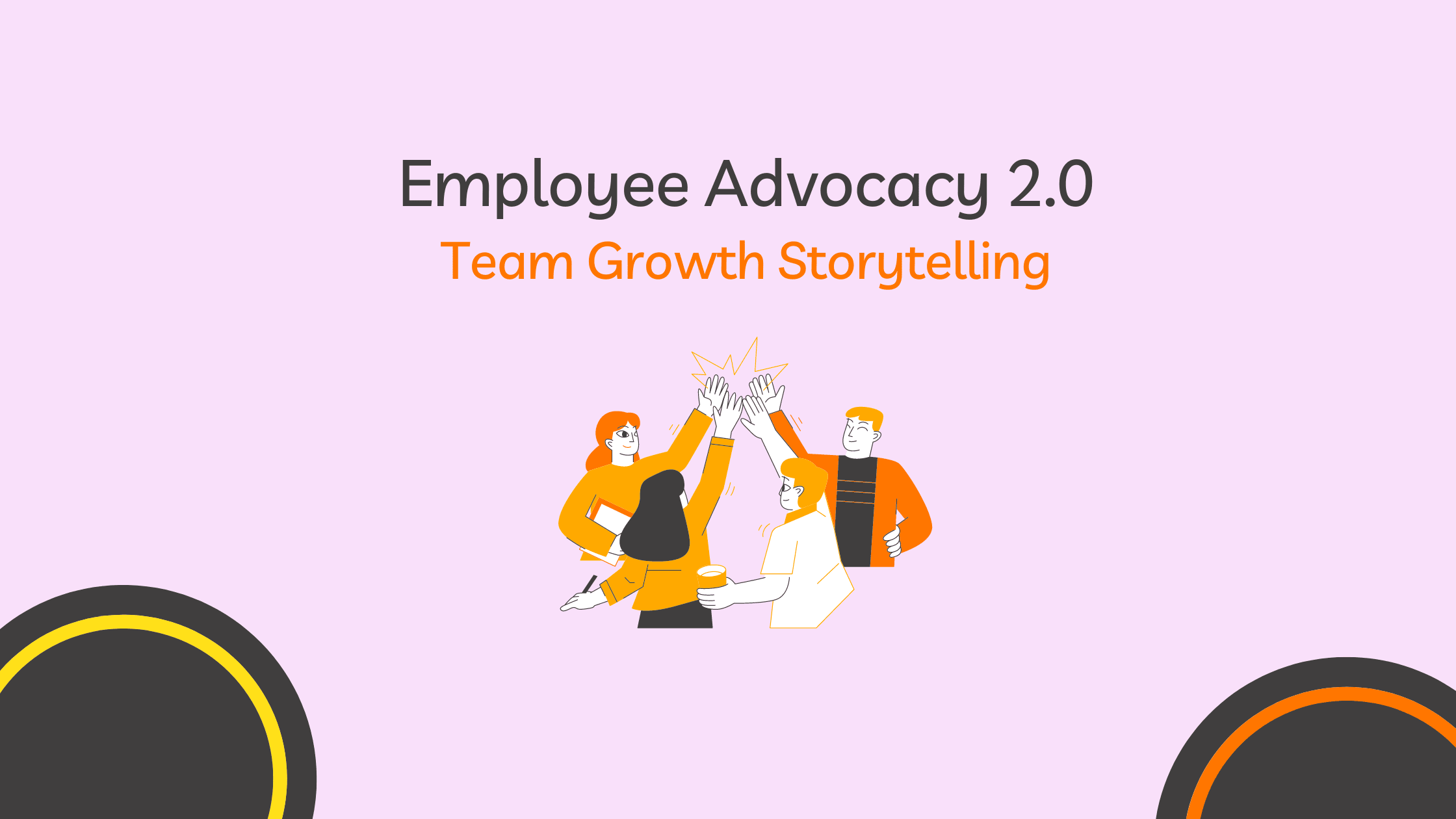Employee Advocacy 2.0: Team Growth Storytelling
Yes, connecting the voices of your people to the growth of your brand can be that simple
Employee Advocacy is clearly the direction that B2B and SaaS marketing are evolving towards. If well implemented, more organic reach, more engagement and more growth come from this social media strategy than any other. And Employee Advocacy doesn’t have to be such a struggle.
There’s more to your story, and those of your people. Let’s get it out.
In this article
If you’re still only posting on your company’s social profile and hoping that’s gonna win the war for organic reach & engagement on social media…You’ve got some pretty hard times ahead.
Here’s why Employee Advocacy 1.0 doesn’t work, and how Employee Advocacy 2.0 will help grow your Brand, Demand Gen, and Social Selling.
Here’s your company online and on social media:

Imagine you’re in the town square.
It’s a buzzing square, with some people you know and a lot of people you don’t know. For some reason, there’s a goat. Children playing.
You notice that there are already quite a lot of stalls from merchants selling their wares, and a lot of people putting up and handing out signposts and pamphlets; loud salespeople randomly trying to strike up conversations with passersby.
There are even some folks who are seemingly constantly getting up on milk crates to tell whoever wants to listen to their thoughts and feelings, their beliefs, and their knowledge about how to have a better life; to solve XYZ, to reach your goals.
Now what about you?
You have some products or services to sell as well. You genuinely believe they can be of value to people, hopefully — or at the very least you feel they’re valuable enough to some people that it can help pay for your costs of living plus the ones you protect and provide for.
So you set up your stall, too.
Your Brand Spanking New Website & Social Profiles

But, imagine your surprise: nobody comes – except for your mom and some random bearded guy who thought you were handing out free cookies.
So what do you do? You decide to quickly hire or find someone on your team, who can hopefully help draw some attention to your stall and your goods or services.
Your professional attention-seeker.
But oh, well, what do you know? They have hardly any success. No one wants to read their pamphlets, no one wants to listen to their stories about your products or even about the problems you solve and how wonderfully you solve them.
Your next move?
Your Company on Employee Advocacy 1.0

You come to the conclusion that people don’t want to hear from brands, they want to hear from people.
So: you ask everybody who works for you, the people who you work with as partners, and some of your past customers, to please share and pass on the pamphlets your attention-seeker colleague is passing out.
To please stand still and listen to what your salespeople and professional attention-seeker are saying when they get up on their milk crates, so as to hopefully get more people to pay attention because of humans’ ancient instinct for herd behavior.
— And why it doesn’t work
This is what Employee Advocacy usually ends up being, nowadays.
“Will you please share our company social post on your own profile as well?”
“Will you please use this additional tool to like, share, and respond to our branded social media?”
But that’s not what you really want to have happen.
Because this is not how people pay attention, build connections and trust, learn, and finally come to mutually beneficial agreements — business or personal.
What do we humans want?
What do humans naturally do in the town square, that helps build these things?
They walk around and have conversations with their friends.
They check out stalls and strike up conversations there — if and when they themselves feel inclined to. If they have a problem to solve, they’ll ask their friends or trusted, unbiased connections in their network or even new friends, what their experiences are with certain problems, about potential solutions and how to use them, and who to go to for specific tools or help with certain things; the pricing and their experience with those people.
What a lot of us in the market are seemingly trying to create, with the way we think about and approach employee advocacy, is a town square where most of us spend most of our day standing on milk crates, telling stories about how wonderful our company is. But naturally, from a human perspective, hardly anyone actually wants to do that, and at least equally importantly: hardly anyone wants to listen to it.
What we want are actually honest, inspiring, and transformative stories.
These we’ll gladly listen to, remember, and re-tell to all our friends. That’s why great movies, series, and books grow to reach so many people — without massive employee advocacy campaigns on social media.
Humans Love Great Stories.
So: if today you don’t have a wonderfully transformational, revolutionary piece of insight or knowledge to share in the form of a beautiful story: why not be quiet for a day? There’s a shocker.
Maybe browse for stories from other people, find one that resonates with you, one that the sharing of with other people aligns with who you are and where you want to grow, and share that?
What we want is to be seen and heard.
These are natural human instincts, needs as deeply ingrained in our DNA as our necessity to breathe air or to drink water. So why don’t we focus on listening more, on social media? Listen, acknowledge, and from time to time even respond.
When you do respond, do so with the intention of first acknowledging the other human being, second clarifying understanding of what has been said, and thirdly adding to the conversation — the opposite of this, by the way, is to “retaliate” with all of the brilliant arguments as to why they’re wrong and you’re so right. Except when it’s actually necessary and the conflict or clash will add to the general conversation.
What we want are actual conversations.
We’re often happy to engage in these, but only when it’s on our own terms.
So: instead of always putting up signposts with a statement, why not put one up with a poll once in a while? Let people who feel strongly invited to add to the conversation come join you.
What we also really want is honest, truthful exchange between people belonging to the same organization online — instead of this cringy mutual belly rubbing by applauding each other’s shared pamphlets and signposts and even milk crate sessions with void compliments.
Why not bring some of the true, honest discussion that goes on inside, to the forefront on the outside of your conversation, and draw other people in, inviting them to add their own insights?
Why not add more entries to conversation than the one that is — overtly or covertly — labeled ‘sales’?
My buddy and StoryLab.ai CEO and co-founder Brian Cohen actually wrote an insights-packed book about how to shift your Demand Generation strategy to one that is focused on something he calls “Conversation Generation”. Ready to think beyond the demo? Then it’s definitely worth your time to check out Brian’s book.
What we want is to make an honest, actual, human connection.
And we make those when we are free, inspired, facilitated, and applauded for being ourselves; sharing our own truth, our own growth and our own passions, insights and knowledge as we see fit. Lacing the points that are relevant to the company or organization that we belong to with a natural, organic connection to or mention of the company; its story, its goods and services — if and when we see fit, and if and when we deem it natural to the conversation.
Your people’s identity, their story, and their conversation are not made up out of their being associated with your company. That is only one small part of it. See to the growth of the people that are associated with you or your company, first and foremost — including online. This will enable them to grow, and in turn enable your company to grow along with them. Not the other way around.
Employee Advocacy 2.0: Team Growth Storytelling

When human beings and brands alike listen, respond to and tell stories online, what they’re actually doing without even realizing, is telling the story of their growth. Think about it: the posts you were sharing 5 years ago or even 1 year ago are not the posts you’d probably share today. Makes sense; you’re not the same person and you’re not the same company.
Hopefully.
And the stories that we share are, to whatever extent, geared to helping others to grow, and to help ourselves to grow.
Hopefully.
What this means, is that we’re all actually already Growth Storytelling.
So what is this Growth Storytelling?
Growth Storytelling is an approach that uses the transformational power of storytelling for business and personal growth. Read more about how to apply it within the context of marketing, here.
So, apply Growth Storytelling for and as a Team, instead of rolling out a new Employee Advocacy 1.0 experience. Understand and grasp the transformative power of shared storytelling; so you can harness the dormant power of the Growth Storytelling you and your people are already practicing.
And do it as follows:
How to tell Growth Stories as a Team
- Listen to the stories that the people you work with, and the people you want to work with, are sharing.
- Figure out how to acknowledge, deepen (with clarifying questions), or add to those stories.
- Inspire, educate, and facilitate your people to create more and better stories and to reach more people with them — with knowledge and tools from a platform like StoryLab.ai.
Share those stories, and broaden the reach of those that you deem most useful or inspiring. Watch your people grow, and as a consequence, watch yourself and your business grow.
At StoryLab.ai, that’s what we’re enabling with our Team Growth Storytelling platform, with AI-generated content to help get you and your people started, and a ton of free resources on how to get better results with storytelling content. Go check it out here: www.storylab.ai.
Shift from “Employee Advocacy” to Team Growth Storytelling, and support your People, Grow Brand & Demand, improve Sales, and help more customers with what you know and do best.
From Employee Advocacy to Shared Stories that enable Growth

Employee Advocacy is clearly the direction that B2B and SaaS marketing are evolving towards.
But not the “please share our social posts on your own profile as well” variety.
If well implemented — in the sense of Shared or Team Growth Storytelling — more reach, more engagement and more growth can come from this social media strategy than any other. And getting the voices of your people heard doesn’t have to be such a struggle.
Especially if you remember it’s about the people themselves, first, their own unique voice, second – and only third the association with your company;
Growing your brand, thought leadership, demand generation, and social selling effectiveness almost as a happy bonus.
Grow your people, grow your business. It’s really that simple.
There’s more to your story, and those of your people. Let’s get it out.
Top AI Marketing Generators
Author bio:
 Erwin Lima: What inspires Erwin is helping people, teams and brands to become the best version of themselves. Guiding them with curiosity, empathy, and Growth Storytelling.
Erwin Lima: What inspires Erwin is helping people, teams and brands to become the best version of themselves. Guiding them with curiosity, empathy, and Growth Storytelling.
Over the past 10+ years as a copywriter, author, consultant, and coach, he’s helped dozens of Brands, Teams, and individual human beings to grow their sense of motivation and focus, but also their reach, engagement, and revenue— through the power of their own story. You can find Erwin on LinkedIn and on his website.
Master the Art of Video Marketing
AI-Powered Tools to Ideate, Optimize, and Amplify!
- Spark Creativity: Unleash the most effective video ideas, scripts, and engaging hooks with our AI Generators.
- Optimize Instantly: Elevate your YouTube presence by optimizing video Titles, Descriptions, and Tags in seconds.
- Amplify Your Reach: Effortlessly craft social media, email, and ad copy to maximize your video’s impact.